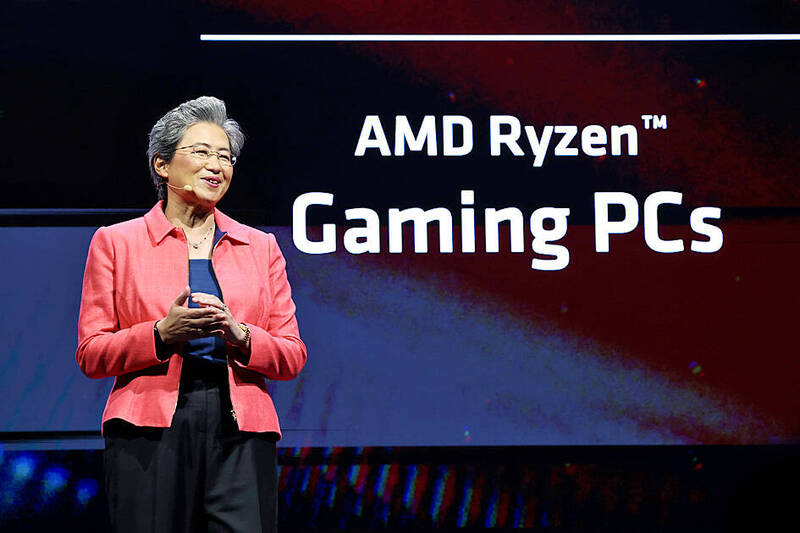《TAIPEI TIMES》AMD, TSMC to produce new chips

AMD chief executive officer Lisa Su delivers a keynote speech ahead of the Computex Taiwan trade show at the Taipei Nangang Exhibition Center yesterday. Photo: Ritchie B. Tongo, EPA-EFE
STRONG PARTNERSHIP: Taiwan is very important to the semiconductor ecosystem and AMD does a lot of manufacturing here with key suppliers, CEO Lisa Su said
By Lisa Wang / Staff reporter
Advanced Micro Devices Inc (AMD) yesterday said it is collaborating with Taiwan Semiconductor Manufacturing Co (TSMC, 台積電) to produce its next-generation chips utilizing the 3-nanometer process technology of the world’s biggest foundry service provider.
AMD’s remarks came amid speculation that the US-based chip company might consider adopting Samsung Electronics Co’s 3-nanometer process technology, given that supply of TSMC’s 3-nanometer process technology is constrained.
“AMD is always going to use the most advanced technology and we are certainly going to use 3-nanometer. We’re certainly going to use 2-nanometer and beyond,” AMD chief executive officer Lisa Su (蘇姿丰) told a media briefing following her keynote speech at the Computex Taipei trade show.
AMD “did not say specifically that we’re going to use any particular vendor for 3-nanometer or gate-all-around [GAA]. Our current partnership with TSMC is very strong. We talked about some of the products in 3-nanometer that we are doing right now,” Su said in response to a reporter asking if she had implied that Samsung had been picked because of its GAA technology.
Su last week attended the Imec ITF World 2024 conference in Belgium and unveiled the firm’s plan to mass-produce next-generation chips using 3-nanometer GAA technology at a forum, the Korean Economic Daily reported on Wednesday last week.
Samsung is the only chipmaker to produce 3-nanometer chips based on GAA technology, or a nanobar technology, a major shift from the existing FinFET technology.
Similarly, TSMC also plans to migrate to a new transistor architecture called nanosheet transistor technology for its 2-nanometer chips with higher transistor density and more power efficiency.
TSMC plans to start volume production of 2-nanometer chips next year.
AMD yesterday kept a low-key attitude about its investment in a new research-and-development (R&D) center in Taiwan, when asked about the project that is reportedly costing about NT$5 billion (US$154 million).
“Taiwan is a very important area for us to do research and development,” Su said.
AMD already has more than 1,000 employees in Taiwan taking care of a significant amount of development for a wide range of the company’s product portfolio, including PCs and data centers, as well as our supply-chain partnerships, Su said.
“We are always looking at how we partner in R&D in the region,” Su said.
“So we are continuing to look at what we do in Taiwan. I probably do not have any exact information on the R&D centers at this moment, but we’re looking at all of these,” she said.
Taiwan is “very, very important to the semiconductor ecosystem,” Su said. “We do a lot of manufacturing here with, you know, key suppliers like TSMC, like many of our back-end partners, and many of our substrate partners are here as well.”
AMD has a number of partners that help it build out the ecosystem in Taiwan, such as its contract manufacturers and original-design-manufacturing partners, Su said.
“We are very much a believer in a global semiconductor supply chain,” Su said.
The Ministry of Economic Affairs last week confirmed that AMD had submitted an investment plan, indicating its intention to set up a R&D center in Taiwan under the government’s A+ Industrial Innovative R&D Program.
If the investment plan is approved, AMD could get a substantial subsidy from the government.
Nvidia Corp is reportedly looking at setting up a second R&D facility in Taiwan.
The chip supplier set up its first R&D center focusing on artificial intelligence technologies with a total investment of NT$24.3 billion over a five-year period to 2027. It received about NT$6.7 billion in government subsidies, the ministry said.
新聞來源:TAIPEI TIMES























